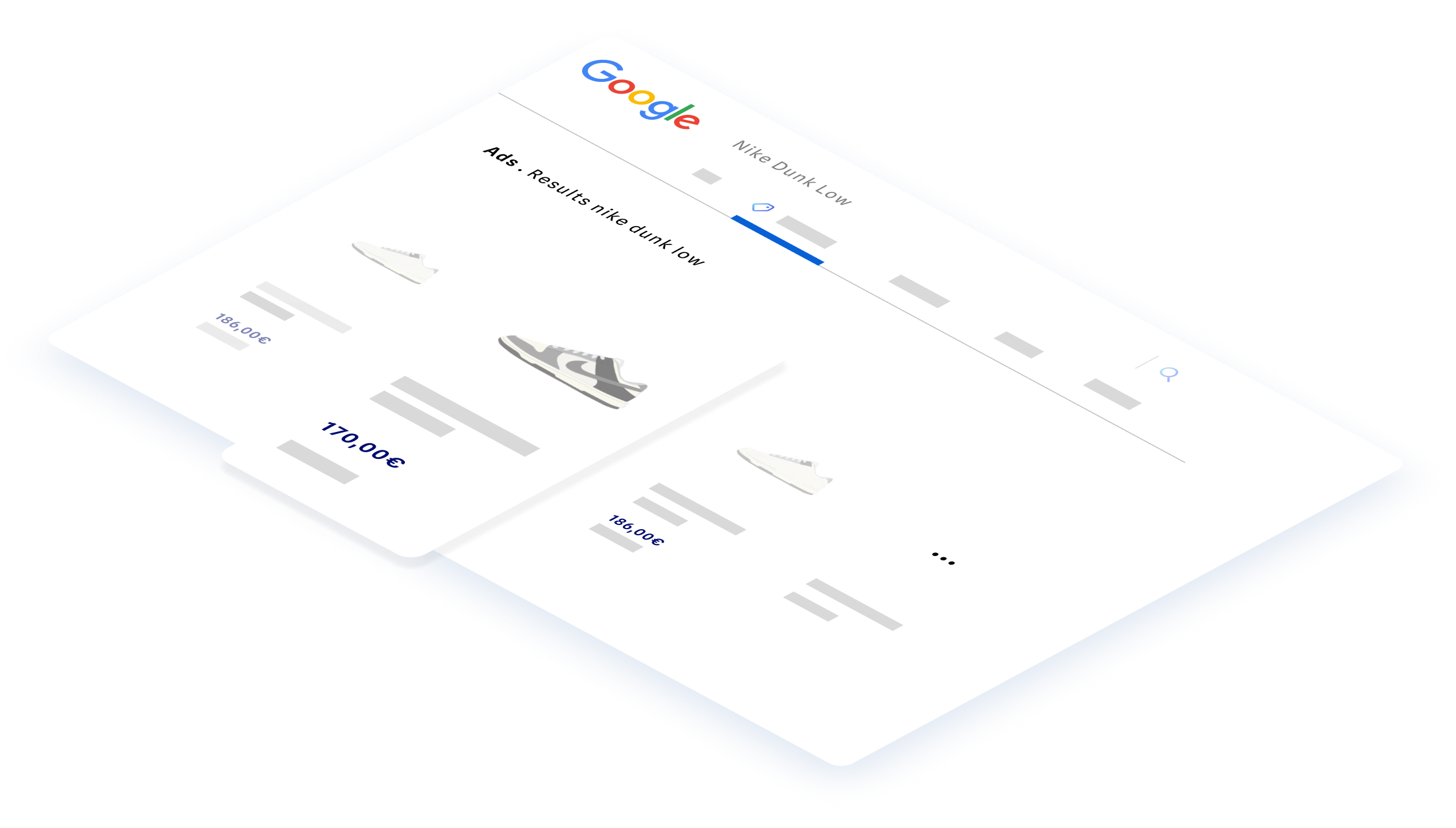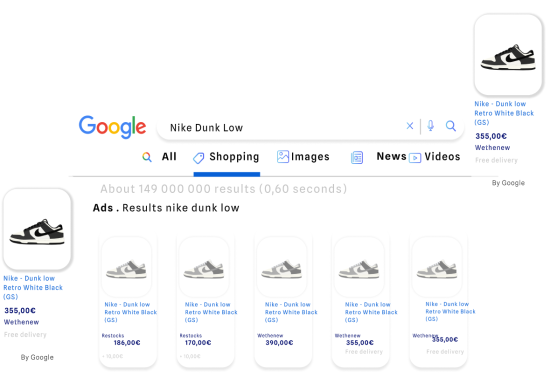
Google Shopping:
A valuable acquisition tool for e-merchants
Google Shopping has rapidly become a crucial tool for e-commerce players, provided that you understand the nuances of Shopping campaigns!

What is Google Shopping?
How does it work?
What’s Google Shopping?
Google Shopping is an e-commerce platform that’s hosted by Google. It’s a hybrid service that combines features of a marketplace (such as Amazon), a search engine, a price comparison tool, and an advertising campaign. Products listed on this platform can be found both in regular search results (under the “All” tab) and in the specific “Shopping” tab, which displays up to 30 ads on desktop and 15 ads on mobile devices. As the platform has become more successful over time, Google has developed an ad format specifically for Shopping and expanded the reach of campaigns to include the entire Display network and partner sites.
How does Google Shopping work?
Google Shopping operates on an economic model that’s similar to that of Google Ads advertising platform, which uses a cost-per-click (CPC) bidding system. Although free Shopping listings were reintroduced in 2020 to support e-merchants during the pandemic, paid ads still provide the best positions in search results, and they typically receive the majority of clicks. Other factors, like customer reviews, the quality and relevance of text and images, also play a role in the ranking of ads, although they’re less important. For the rest, Google Shopping determines on its own which queries trigger the appearance of ads, based on two main factors: your product feed and the content of your e-commerce site. That’s why SEO is so important for this part of your online business.
Features of Google Shopping
-
Displaying product ads
Similar to a marketplace, Google Shopping displays ads for products based on keywords entered by users. The box typically includes an image, brief description, purchase price, and shipping costs. Users can click on the ad to access additional information and compare offers. A link then directs them to the merchant’s website.
-
Price comparison
Google Shopping also serves as a price comparison tool. From a given ad, the user can access a table that shows different sellers offering the same product, with prices, delivery fees, and customer reviews for the item. This provides the user with the information to make an informed decision and select the most appealing offer.
-
Ad reach
Google Shopping ads appear in several places. They are found in the classic SERP, of course, as well as in the dedicated “Shopping” tab. To increase their reach, they can also be configured to appear on Google’s Display Network, on Shopping apps, and on the network of partner sites and apps, giving them significant visibility.
-
Ad configuration
The functioning of Google Shopping is similar to that of a marketplace. To sell their products, merchants must send their product feed through Google Merchant Center and then carefully configure their Shopping ads, including defining their goals and budget, adjusting bids, selecting the ad type, and choosing retargeting options, among others. This configuration differs from that of Google Ads’ text ads.
-
Buy on Google program
Google Shopping offers sellers the option to join the “Buy on Google” program, which displays an icon shaped like a shopping basket on relevant products. This allows users to pay directly on Google. The platform informs the merchant through the Merchant Center, provides them with delivery instructions, and then reimburses them the value of the order (minus an average commission of 12%).
-
1.2m
people
use Google Shopping -
85%
start on
Google or Amazon -
63%
have already clicked
on a Google ad
What are the advantages of Google Shopping?
Why use Google Shopping?
Google Shopping ads offer all the advantages of Google Ads without the typical drawbacks associated with sponsored links. Firstly, products sold on Google Shopping benefit from Google’s incredible amplification – SERP, Display, partner sites, and more. Given that 40% of all product searches start on Google, this visibility is significant. Secondly, while the initial setup of Shopping ads may be more complex than Ads, the long-term effort required is much less. The reason is simple: Google does most of the heavy lifting, automatically fetching information from your e-commerce site and product feed, creating the ads itself, and associating them with relevant queries.

The benefits of Google Shopping
Let’s take a closer look at the advantages that Shopping ads offer for online sellers.

-
High visibility on Google
Shopping ads have the best placement in the SERP: above the sponsored links. Moreover, the format (a vertical box illustrated by a product photo) immediately catches the eye, at the expense of both Ads and organic links. Therefore, these ads receive more clicks than traditional links, to the benefit of the sellers.
-
A powerful conversion lever
Google Shopping relies on the philosophy of “Show, don’t tell”: images are more compelling than Google Ads text. This makes the ads more attractive and allows internet users to identify the products they are looking for much more easily than by reading descriptions. It makes Google Shopping a powerful tool for decision-making and conversion.
-
Intention-based ads
Most ads are disruptive: they impose themselves on consumers, regardless of their intentions. In contrast, Shopping ads are based on search intent: they appear when internet users are specifically searching for the product in question. This means they are more likely to click on the ad, as they are already in a buying mindset!
-
High profitability on Shopping
Google Shopping offers one of the best ROIs among advertising channels. The average cost per click is $0.66, compared to $1.16 for Google Ads (source), which allows advertisers to plan a lower budget for their campaigns – while benefiting from an average conversion rate of 1.91%. Profitability is therefore achievable, provided that one has a good grasp of Shopping’s codes.
Google Ads v Google Shopping:
Which platform is best for you?
Google Ads
- Text-only ads
- Displayed above and below organic search results, in groups of 3 or 4
- Use of ad extensions to display additional information
- Ads shown in response to user queries, following a keyword-based bidding system
- Open to all types of e-commerce, including products, services, subscriptions, hotel and restaurant bookings, and more
- CPC generally higher than on Shopping
VS
Google Shopping
- Ads featuring both text and images
- Displayed prominently at the top of the SERP and within a dedicated tab called “Shopping”; up to 30 ads on desktop and 15 on mobile
- More appealing ads with images providing extra information upon clicking
- Ads shown in connection with specific queries based on information from the product feed and merchant website content
- Only available for physical products that can be sold online, and a select few services
- CPCs generally lower compared to Google Ads
Good to know
There’s no need to choose between Google Ads and Google Shopping – combining the two platforms is key to optimising your visibility, increasing your click-through rates, and generating more sales. According to Google, users who see both Shopping ads and sponsored links for a particular product are 90% more likely to visit the merchant’s site and 83% more likely to make a purchase!
How to sell your products on Google Shopping
Step one: create a Google Shopping account
To create and set up an account on Google Shopping, you need to go through the Google Merchant Center. You’ll need a Google account and can access the platform via this link. Here are the main steps of the registration process.
-
Provide information about your business
Specify the name of the company, website or store (this name will also be the name of your Merchant Center account and the one that users will see on Google), the address (the time zone is automatically filled in based on the country) and the phone number. If you have already verified a Google business listing, you won’t need to take these steps.
-
Choose your preferred payment options
Google Merchant Center offers three payment options: accessing your website to complete the purchase (“On your website”), buying the product without leaving Google (“On Google”), or visiting a physical store (“In store”). These options can be changed at any time in the future.
-
Integrate third-party e-commerce platforms
If you’re using third-party platforms like Shopify or PayPal, Merchant Center offers the option to integrate them into your account to promote the same products on Google Shopping or to provide additional payment options. You can associate other platforms at any time through the same configuration tool.
-
Associate your account with Google Ads
Once on the Merchant Center interface, go to “Linked Accounts” to link your Google Ads account. To do this, you need to have administrator access. The connection can be verified by going to the same tab on your Ads account. Once completed, you can import your product feed and start configuring your Shopping ads.
Step two: create a product feed
-
Create a product feed manually
In a spreadsheet (such as Excel or Google Sheets), enter all the products to be transformed into Shopping ads. Google requires attributes to be filled in: ID, title, description, price, condition, link, category, etc. Be sure to complete these attributes and choose the relevant category: this will allow Google to effectively place your ads based on queries.
-
Automatically create a product feed
If you’re already selling your products on an e-commerce platform like Magento or Shopify, you can use an application or extension to automatically generate your product feed. Google takes care of a significant portion of the work, and the application you use will alert you to any errors that need fixing in the feed to ensure it’s perfect.
Step three: create and configure a Shopping campaign
Once your product feed has been uploaded to Merchant Center, it’s time to create your campaign.

-
STEP 1
Select the type of Shopping campaign
You can choose between a “Standard” Shopping campaign and a “Smart” campaign. The first option allows you to control all your variables (while Smart campaigns are fully automated), but its reach is limited, and the display is focused on the Search environment. However, it is a good way to get started.
-
STEP 2
Choose your Shopping bidding strategy
Google Shopping offers three bidding strategies: a maximum conversion strategy based on a target ROAS (ROAS: Return On Ad Spend), a maximum clicks strategy within the fixed budget limit, and an automatically adjusted bid strategy based on the probability of generating a click (known as “optimised CPC”).
-
STEP 3
Set your Google Shopping budget
Google Shopping’s bidding system works based on each click. With a “Standard” campaign, you can set the maximum CPC (cost-per-click) for each product. With a “Smart” campaign, Google takes care of this automatically by seeking to optimise your CPC to boost your conversions.
-
STEP 4
Effectively target your Shopping ads
Depending on the type of campaign you choose, you can select the display settings for your Shopping ads: on Google Search, on partner sites, and/or on the Display Network. You can also select specific geographic areas and languages, based on the countries targeted by your e-commerce strategy.
-
STEP 5
Identify negative keywords
Unlike Google Ads, Google Shopping does not use keywords for its bids. However, you can exclude certain queries through the “Search Terms” tab. This allows you to identify phrases on which you do not want your Shopping ads to appear – for example, negative terms or terms that are contrary to your values.
How to improve your performance on Google Shopping
Optimising your product feed for Google Shopping
Creating a product feed is a critical step in setting up a Google Shopping campaign. It is essential to optimise this feed to provide Google with relevant information and create high-performing Shopping ads. Here are the most important attributes to optimise.
-
Title
The title is the most critical element: it clearly indicates the nature of your product, allowing users (and Google) to know what it is.
-
Images
Along with the title, images are the other major lever capable of influencing buyers. Use them to highlight the product’s strengths.
-
Price
The displayed price is a powerful conversion driver, especially if the same product is offered by several sellers. It’s a great way to differentiate your ad.
-
Description
Visible only to buyers in the Shopping tab, the description provides relevant information about the product (use, benefits, specifications, etc.).
-
Category
Google offers a list of categories and subcategories: carefully choose those that match your product so that Google knows when to display your ad.
-
Type
This free-form field can be used to place keywords, which Google will use to position your Shopping ads optimally.
-
Additional Details
This field allows you to provide any additional information you feel is relevant about your product, such as dimensions, technical specifications, compatibility, etc.
-
Brand
The brand is a required field. It is relevant for your branding, but it is also a way to highlight your ad on a brand query.
-
Availability
It is important to indicate the availability of the product. Google Shopping offers four options: in stock, out of stock, pre-order, and backorder.
Adjusting bids by understanding your target audience
One of the keys to optimising a Shopping campaign is adjusting bids. Bids determine various important parameters such as how often the ad will be shown in response to a specific search, the targeted geographic location, the preferred channel, and more. Therefore, it is essential to have a good understanding of your target audience. Who are your customers? Which pages or product listings do they visit most frequently? Why do your potential customers abandon their shopping basket? This information is combined with reports generated from your actual sales (which products are the top sellers? What are the trends?), letting you establish very precise customer profiles and adjust your Shopping bids accordingly.

Making your shopping campaign more effective
Here are three major levers to optimise your Google Shopping campaign and make it more effective.
-
Running special offers
Google Shopping allows you to set up a “promotional feed” which, when activated, displays the text “special offer” on the ad, along with details about the type of promotion (discounted price, bundle offer, free shipping, etc.). Use this feature wisely to highlight products at key moments in your campaign. Before doing so, you need to request to be added to the whitelist for promotions via Google Ads.
-
Dynamic retargeting
Retargeting involves customising a campaign based on the behaviour of users who have already visited your site or added items to their cart without checking out. On Google Shopping, you can configure your bids to specifically target users based on their browsing history. Based on this data, Google will create ads focused on the viewed or saved products and display them to the relevant users.
-
Incorporating customer reviews
On Google Shopping, as with other platforms, consumer reviews have a significant influence on purchase decisions. They also boost SEO, thus improving ad visibility. However, integrating customer reviews into Shopping ads is not automatic; prior approval from Google is required. You can also display “merchant reviews,” i.e., comments related to your store or brand.
Good to know
To succeed on Google Shopping, it’s important to have highly relevant ads achieved through an optimised product feed, a campaign structure that gives you the desired level of control, and detailed reporting data that enables you to make informed decisions at the right time.
Our Commitment
-
Expertise
Since 2010, we have worked with over 2000 clients across 90 countries.
-
Passion
We are a team of passionate, industry-focused individuals who are committed to your success.
-
Performance
We’re committed to implementing a data-driven strategy, making a real impact on your bottom line by providing avenues for growth.
Any questions?
Google Shopping is Google’s e-commerce platform. It functions as a search engine, marketplace, advertising campaign, and price comparison tool. Shopping ads are visible in Google search results, in a dedicated tab called “Shopping,” as well as on Google’s network of partner sites and apps, depending on the settings.
Using Google Shopping to sell products comes with multiple benefits, including high visibility on Google (since 40% of product searches on the web start on this search engine), a higher conversion rate thanks to ads that take into account user intent, and strong profitability (the average CPC for Shopping is lower than for Google Ads).
To start selling products on Google Shopping, you need to create an account on Google Merchant Center and associate it with an existing Google Ads account. Then, you’ll need to create and configure a product feed (manually or automatically) and upload it to Merchant Center. Finally, launch a Shopping campaign using the features offered by Google.












